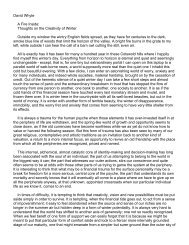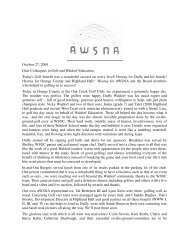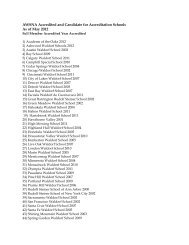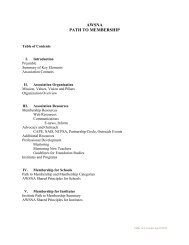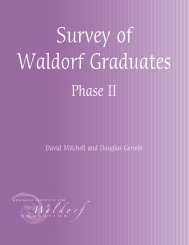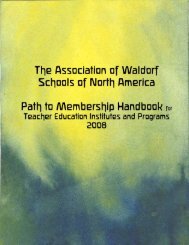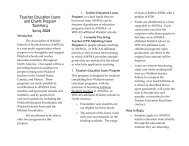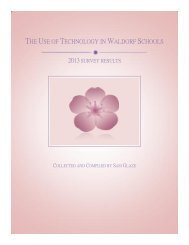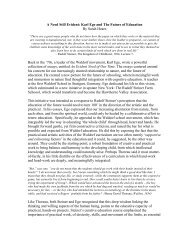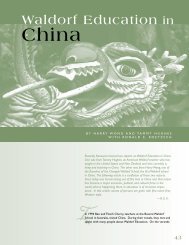Interview with Megan Durney by Sarah Hearn - Why Waldorf Works
Interview with Megan Durney by Sarah Hearn - Why Waldorf Works
Interview with Megan Durney by Sarah Hearn - Why Waldorf Works
You also want an ePaper? Increase the reach of your titles
YUMPU automatically turns print PDFs into web optimized ePapers that Google loves.
Leading Green Thinkers and Doers: <strong>Megan</strong> <strong>Durney</strong>The following interview <strong>with</strong> <strong>Megan</strong> <strong>Durney</strong>, Head Gardener at the Pfeiffer Center(linkto:http://www.pfeiffercenter.org/index.aspx) in Spring Valley, NY, is the first in aseries of AWSNA interviews <strong>with</strong> leading green Thinkers and Doers connected to <strong>Waldorf</strong>Education. <strong>Megan</strong> shares from her work in the garden <strong>with</strong> both adults and children andher experience that through <strong>Waldorf</strong> Education children can cultivate a sense of servicetowards the Earth and its creatures. <strong>Interview</strong> <strong>by</strong> <strong>Sarah</strong> <strong>Hearn</strong>.<strong>Megan</strong> <strong>Durney</strong>, Head Gardener<strong>Megan</strong>’s previous experience includes several years of volunteer and community servicework, including two years in the southeast after Hurricane Katrina, and organic farmingas a WWOOF-er. Following those experiences, she says, "I wanted to do consciousagriculture--making more of the spiritual connection <strong>with</strong> the earth. I've always beeninterested in healing work <strong>with</strong> people and <strong>with</strong> the earth, so I felt like biodynamicswould tie those together. Other farms I've been on were a lot of labor, but not a lot ofconsciousness; even organic farms could feel depleting." <strong>Megan</strong> interned at the PfeifferCenter in 2006-7 under Gunther Hauk, and continued as Garden Assistant when MacMead became Program Director of the Pfeiffer Center. <strong>Megan</strong> is a graduate of the NorthAmerican Biodynamic Apprenticeship Program.1
SH: Could you tell us a bit about your work/the work of your organization in relationshipto <strong>Waldorf</strong> Education?MD: I was an education major in college and eventually received a teaching certificate toteach 6 th -12 th grade English. In the public school system, I soon experienced as a teacherin-trainingthere were many barriers to really connecting to the student as a human being.There seemed to be a lack of support to creatively teach and assess students. Teachersseemed to be controlled <strong>by</strong> standardized tests instead of being encourage to be anadvocate for human development and to create a wholistic understanding of theindividual needs and inspirations of the students, themselves or other co-workers.Soon after I graduated from college, I experienced <strong>Waldorf</strong> Education through my shortstays at Three Rivers <strong>Waldorf</strong> Initiative and High Mowing, which symbolize thebeginning of a new path of intrinsic learning and exploration into, “What does it mean tobe human teaching other humans?” I always had a deep interest in earth care andeventually found biodynamic agriculture through learning about Rudolf Steiner’scontributions. I presently work at the Pfeiffer Center, a biodynamic educational center,which is situated in the same community at Green Meadow <strong>Waldorf</strong> School.At its foundation, the activity at the Pfeiffer Center focuses on providing educationalexperiences for both adults and children. In my opinion, the approach is human centeredmeaning the teaching revolves around the question of how to facilitateexperiences/processes to help humans truly see the Earth. How can humans experience inthemselves how interconnected they are to the activities of the Earth and it’s creatures.How does the Earth live in me and me in the Earth? This united perspective of the humanand the Earth is the key to the future of our Earth as a living organism. Only <strong>by</strong> trulyuniting the usually disjointed picture of the human separate from the Earth.As a Pfeiffer Center crew we are trying to work <strong>with</strong> imaginative pictures of humandevelopment to guide our garden/farm activities <strong>with</strong> children. We have asked some localtrained <strong>Waldorf</strong> teachers to enhance our education about human development. So far, wehave had two teachers as our guests to share in their experiences in teaching humanbeings, one more focused on the young child and on the middle school aged child.SH: What do you perceive to be the greatest strengths of <strong>Waldorf</strong> Education, towards thecultivation of a genuine ecological consciousness?MD: I have a sense that <strong>Waldorf</strong> education trains teachers to focus on activities,processes and end results. There also seems to be an emphasis on seeing the human beingas 3-fold, of a physical, life and soul/spiritual nature, unfixed always creating and beingcreated. In the teachings, the concentration seems to be on the activity of learning andfostering the developing human being.2



